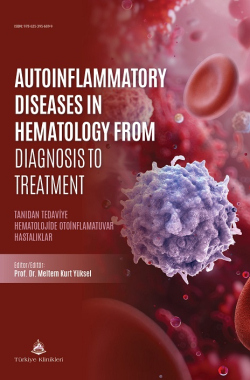INFLAMMATORY HEMATOLOGIC DISORDERS (IHD) ASSOCIATED WITH ABNORMAL SERUM PROTEIN ELECTROPHERESIS (SPEP)
INTRODUCTION
Inflammation is a physiological process aiming to protect the body’s integrity against various threats, including pathogen-associated and damage-associated molecular patterns. The immune system is structured to recognize and distinguish dangerous, non-self-antigens from self-antigens, with multiple control mechanisms in place to prevent self-damage—an idea famously described by Paul Ehrlich as “horror autotoxicus”.
However, certain disorders arise when the immune system mistakenly targets its own tissues, leading to autoimmunity, which is primarily driven by adaptive immunity responses against self-antigens. In the late 20th century, Dr. Dan Kastner and colleagues at the National Institutes of Health, USA, identified the genetic basis of familial Mediterranean fever, followed by familial Hibernian fever (now known as tumor necrosis factor receptor-associated periodic syndrome).1-3 To differentiate these monogenic disorders from autoimmune diseases, they introduced the term “autoinflammatory” highlighting their origin in uncontrolled innate immune responses without pathogenic adaptive immunity (such as autoantibodies or self-reactive T cells).3 Today, more than 60 monogenic autoinflammatory disorders have been identified and classified among the “inborn errors of immunity”, alongside numerous multifactorial inflammatory conditions linked to autoinflammatory mechanisms.
A paradigm-shifting advancement in this field was the discovery of somatic variants as drivers of multifactorial autoinflammatory diseases, exemplified by the identification of VEXAS (vacuoles, E1-ubiquitin enzyme, X-linked, autoinflammatory, somatic).4 VEXAS is a clonal disorder caused by somatic mutations in the UBA1 gene within hematopoietic progenitor cells and acquired during adulthood. The expansion of mutated clones, predominantly affecting the myeloid lineage, results in a broad spectrum of inflammatory manifestations, including vasculitis, polychondritis, neutrophilic dermatosis, as well as hematological findings, including myelodysplastic syndrome (MDS). Since its definition, VEXAS has been found to be more prevalent than initially expected, with an estimated prevalence of the pathogenic UBA1 variants in more than 1 in 4,000 individuals over the age of 50.5
These findings have led to the reclassification of many patients with overlapping inflammatory and hematological features under the emerging category of “hemato-inflammatory” diseases.6,7 The involvement of the myeloid lineage plays a crucial role in driving inflammation, and autoinflammatory/autoimmune features are observed in nearly onethird of patients with MDS and chronic myelomonocytic leukemia (CMML).8 Additionally, clonal hematopoiesis with associated variants, such as those in TET2, have been implicated in other multifactorial inflammatory rheumatic conditions, including giant cell arteritis, rheumatoid arthritis, systemic lupus erythematosus, systemic sclerosis, anti-neutrophil cytoplasmic antibody-associated vasculitis, and beyond.9-13
The concept of autoinflammatory diseases, once limited to monogenic disorders, has now evolved with the recognition of VEXAS and other multifactorial conditions driven by somatic variants. This new dimension is expected to transform both diagnostic and therapeutic strategies for a significant subset of patients presenting with inflammatory and hematological manifestations.
Prof. Dr. Ahmet Gül
İstanbul University, Faculty of Medicine,
Department of Rheumatology,
İstanbul, Türkiye
Referanslar
- The International FMF Consortium. Ancient missense mutations in a new member of the RoRet gene family are likely to cause familial Mediterranean fever. Cell. 1997;90(4):797-807. [Crossref] [PubMed]
- French FMF Consortium. A candidate gene for familial Mediterranean fever. Nat Genet. 1997;17(1):25-31. [Crossref] [PubMed]
- McDermott MF, Aksentijevich I, Galon J, et al. Germline mutations in the extracellular domains of the 55 kDa TNF receptor, TNFR1, define a family of dominantly inherited autoinflammatory syndromes. Cell. 1999;97(1):133-144. [Crossref] [PubMed]
- Beck DB, Ferrada MA, Sikora KA, et al. Somatic mutations in UBA1 and severe adult-onset autoinflammatory disease. N Engl J Med. 2020;383(27):2628-2638. [Crossref] [PubMed] [PMC]
- Beck DB, Bodian DL, Shah V, et al. Estimated prevalence and clinical manifestations of UBA1 variants associated with VEXAS syndrome in a clinical population. JAMA. 2023;329(4):318-324. [Crossref] [PubMed] [PMC]
- Henrie R, Cherniawsky H, Marcon K, et al. Inflammatory diseases in hematology: a review. Am J Physiol Cell Physiol. 2022;323(4):C1121-C1136. [Crossref] [PubMed]
- Patel BA, Ferrada MA, Grayson PC, Beck DB. VEXAS syndrome: an inflammatory and hematologic disease. Semin Hematol. 2021;58(4):201-203. [Crossref] [PubMed] [PMC]
- de Jesus AA, Chen G, Yang D, et al. Constitutively active Lyn kinase causes a cutaneous small vessel vasculitis and liver fibrosis syndrome. Nat Commun. 2023;14(1):1502. [Crossref] [PubMed] [PMC]
- Bucala R, Tsao BP. The emerging spectrum of somatic mutation in rheumatic disease: clonal hematopoiesis connects aging with giant cell arteritis. Arthritis Rheumatol. 2024;76(3):351-353. [Crossref] [PubMed] [PMC]
- Savola P, Lundgren S, Keranen MAI, et al. Clonal hematopoiesis in patients with rheumatoid arthritis. Blood Cancer J. 2018;8(8):69. https:// [Crossref] [PubMed] [PMC]
- David C, Duployez N, Eloy P, et al. Clonal haematopoiesis of indeterminate potential and cardiovascular events in systemic lupus erythematosus (HEMATOPLUS study). Rheumatology (Oxford). 2022;61(11):4355-4363. [Crossref] [PubMed]
- Ricard L, Hirsch P, Largeaud L, et al. Clonal haematopoiesis is increased in early onset in systemic sclerosis. Rheumatology (Oxford). 2020;59(11):3499-3504. [Crossref] [PubMed]
- Arends CM, Weiss M, Christen F, et al. Clonal hematopoiesis in patients with anti-neutrophil cytoplasmic antibody-associated vasculitis. Haematologica. 2020;105(6):e264-e267. [Crossref] [PubMed] [PMC]

